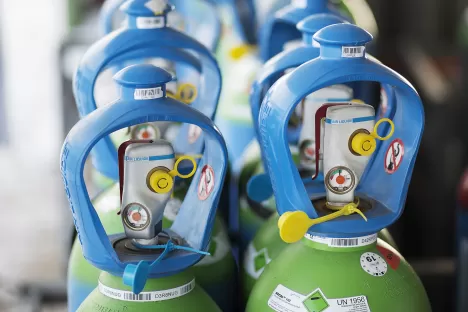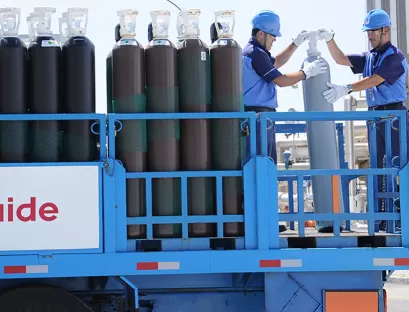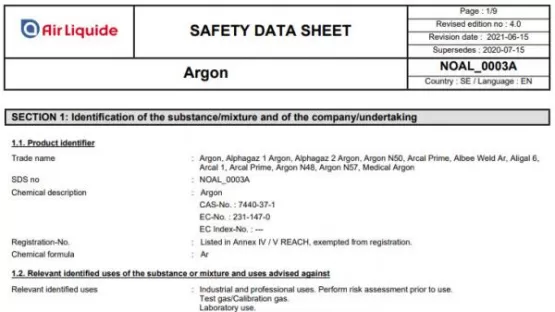Guide to Handling and Storage of Gas Cylinders

Musculoskeletal disorders (MSDs) are the most common occupational illness in Great Britain; affecting 1.1 million people a year. An estimated 12.3 million working days are lost annually to work-related MSDs.
Gas cylinders are generally heavy and are relatively unstable due to the base diameter to height ratio. Large cylinders can weigh over 100kg when full and being tall and thin they are easily toppled over. This TIS has been produced to help users of large gas cylinders to handle them in a safe manner.
- Cylinders are heavy and should be handled with care. Cylinders should not be dropped or subjected to impact when being moved or used.
To handle cylinders safely you will need specific training in safe handling techniques. Speak to your employer or gas supplier for further information on training that may be available.Assess the risk before lifting or moving the cylinder.
If there are 5 or more employees in your organisation, the law requires that a formal manual handling risk assessment be undertaken and the significant findings recorded. This will identify the specific precautions to take when moving the cylinders in your workplace.
Ensure that you know the weight of the cylinder being handled.Check how far and over what type of surface the cylinder is to be moved. You should clear away any obstructions and debris on the route. Ensure that you know where you want to put the cylinder before you start to move it.
If the cylinder is to be moved for a distance greater than a few meters, consider using a suitable trolley or other means of transport.
- Wet or cold cylinders are even more difficult to handle as they affect your ability to hold the cylinder securely.
BE aware of your limitations. Ask yourself if you have the ability and technique to safely move the cylinder safely – if not, SEEK HELP.
Before handling or using gas cylinders you must understand the properties and hazards of the gas.
Check the cylinder label to ensure you have the correct gas.
The properties and hazards associated with the gas are given in the safety data sheet so take time out to read it. If in doubt ask the supplier for advice. - Always use appropriate protective equipment, see the safety data sheet. Eyes, hands and feet should be protected when handling or using cylinders. Many injuries to the foot affect the metatarsal (instep) bone. Footwear with metatarsal protection is recommended.
- Do not move the cylinder with the valve open. When the cylinder is empty or you have finished with it, please return it to the supplier. The valve must be closed before transporting.
- If cylinders are leaning over in their pallet or storage bay, do not attempt to straighten them by yourself. Get help and make sure that you know what everyone is to do to avoid trapping each other’s fingers or being hit by a falling cylinder.
Always make sure that cylinder restraints are securely fastened after moving cylinders. - Avoid injury by using correct lifting method when raising a large cylinder from the horizontal position.
Foot position: hip width apart with one slightly in front of the other, astride the valve end of the cylinder.
Bend the knees to lower your body. This will enable your thigh muscles to do most of the lifting.
Ensure that the valve guard is secure then take a firm grip using both hands. Only lift using the guard if it has been designed for this purpose, otherwise grip the cylinder neck.
Keep your back straight throughout its length. This does not mean it has to be vertical. Doing this will help to prevent a slipped disc.
Pull your chin in so that your back is locked in a straight line and look in front rather than at the ground.
Lift decisively with a smooth non-jerking motion. It is done initially by straightening the legs then following through with the arms at the same time walking forward until the cylinder is upright. - When the cylinder is upright do not leave it free standing, but move it to a safe storage area.
The ‘churning’ method requires the use of both hands. One supports the cylinder whilst the other rotates the cylinder (away from the body). It requires the cylinder to be tilted slightly (again away from the body). The method takes some practice and should only be attempted on a firm, even surface. - NEVER ATTEMPT TO STOP A FALLING CYLINDER – GET OUT OF THE WAY.
- Thank you for reading and following this guidance, it will help to ensure your Safety. This information is provided to support and guide you, our valued customer on safe and best practice. This does not override your obligations under the Health and Safety at Work Act to carry out your own risk assessment. All these resources are available to you with an understanding that we do not accept any liability for how you observe this guidance and whether you implement these measures correctly.
- Wet or cold cylinders are even more difficult to handle as they affect your ability to hold the cylinder securely.
Guide to the Transportation of Cylinders

- Check the cylinder label and confirm that it is the gas you require. If you are unfamiliar with the hazards and properties of the gas please ask for the safety data sheet.
- Ensure that you read the safety data sheet. Take time to understand the properties and hazards associated with the gas before transporting or using it. If in doubt ask the supplier for advice. Know what to do in an emergency – evacuate the vehicle/room/workspace – contact your gas supplier for further advice.
- Cylinders are heavy, handle with care. If you are moving large cylinders, use a trolley, or seek help. Take care when handling. Close the valve before moving the cylinder. Do not drop cylinders. Never try to catch a falling cylinder.
- Use appropriate protective equipment, see the safety datasheet. It is recommended that eyes, hands and feet are protected when handling or using cylinders.An open vehicle is recommended for the carriage of all cylinders. This is particularly important for acetylene and LPG cylinders which should be transported and stored upright. If a closed vehicle is used ensure there is adequate ventilation. It is recommended to drive with a window open.
- Secure the cylinder in the boot/load area and remove the cylinder from the vehicle as soon as the journey is completed.
- When you get to your destination store in a secure and well ventilated location, where it cannot be damaged or tampered with. It will assist the Emergency Services if storage areas are labelled, particularly if acetylene cylinders are being stored.
- Keep cylinders cool and away from heat sources, flammable or corrosive material and oil.
- Use in a well-ventilated area. Do not smoke or use direct heat on a cylinder. Turn the cylinder valve off when it is not being used.
- Always use a regulator suitable for the gas and pressure. Do not connect directly to the cylinder valve. The pressure within the cylinder can be up to 300 bar (some 150 times the pressure you put into your car tyre).
- Never use oil or grease on a cylinder valve, it is dangerous. If the valve is tight return the cylinder to the supplier and obtain a replacement. Do not use excessive force to open the valve.
- When the cylinder is empty or you have finished with it, please return it to the supplier. Valves must be closed before transporting.
- Thank you for reading and following this guidance, it will help to ensure your Safety. This information is provided to support and guide you, our valued customer on safe and best practice. This does not override your obligations under the Health and Safety at Work Act to carry out your own risk assessment. All these resources are available to you with an understanding that we do not accept any liability for how you observe this guidance and whether you implement these measures correctly.
Safety data sheets

Safe handling of gases requires that you as the user get to know the product and the safety regulations that apply. Therefore, always read the safety data sheet carefully.
If you have any questions about our safety data sheets, please contact us by e-mail.
Do you have anu questions about the safe handling of gas cylinders?
Please complete our contact form below and we'll come back to you as soon as possible.
